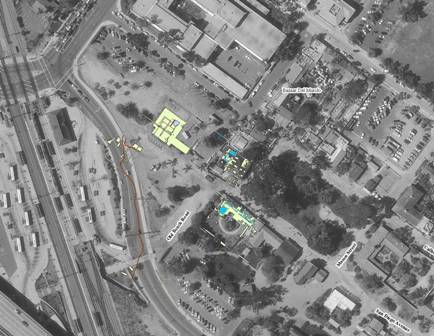Mexicans, Indians and Extranjeros in Early San Diego
 The beginning of the pueblo of San Diego (1820-1850) coincided with the culmination of the Mexican revolution against Spanish rule in 1821. At that time a number of soldiers retired and set up homes outside the presidio. With the opening of California to outside trade, foreigners (extranjeros) also began to make their homes in San Diego; most married into the local Californio population. A third, less visible population included Indian servants; many, but not all, were from the California missions.
The beginning of the pueblo of San Diego (1820-1850) coincided with the culmination of the Mexican revolution against Spanish rule in 1821. At that time a number of soldiers retired and set up homes outside the presidio. With the opening of California to outside trade, foreigners (extranjeros) also began to make their homes in San Diego; most married into the local Californio population. A third, less visible population included Indian servants; many, but not all, were from the California missions.
The Society for Historical Archaeology (SHA) 2006 Conference featured symposium reports on recent archaeological work in an area of Old Town San Diego State Historic Park in which some of the earliest residences were located. The focus was selected aspects of material culture that reflects the three major cultural groups that made up this diverse community.

Larry Felton, Associate State Archaeologist, provided an information on the extensive archaeological investigations conducted at the north end of Old Town San Diego between 1995 and 1999 as part of several related improvement projects. While development and initial archaeology focused on reconstruction of the mansion built there by James McCoy in 1869, voluminous evidence of earlier occupations soon became the primary object of analysis. These data included remains of adobe buildings occupied by several Californio families, and significant amounts of mass-produced consumer goods. Of particular interest, however, were the substantial quantities of artifacts that testify to the ongoing presence of Native American people and technologies as integral parts of the community well into the historic period. His symposium presentation provided an overview of the archaeological work and summarized artifacts recovered that reflect the Native American presence in Old Town. View this entire conference paper presentation (pdf 482kb)

 B. Dalton Oliver Hanowell offered a presentation that was titled "A Ceramic Myriad: Mexican Domesticity and Utility in Old Town San Diego." The ceramic specimens obtained from the McCoy-Silvas site in Old Town San Diego reflect unique characteristics of the basic, but intrinsic necessities of storage, cooking and tableware. Focusing mainly upon the Mexican and Spanish pottery present, his study attempts to envision the ceramics as an important aspect of Old Town domestic life during the late Mexican period. Hanowell also addressed research comparisons to other Mexican sites in Alta California, and the relevance of many non-Mexican wares as represented in the archaeological record.
B. Dalton Oliver Hanowell offered a presentation that was titled "A Ceramic Myriad: Mexican Domesticity and Utility in Old Town San Diego." The ceramic specimens obtained from the McCoy-Silvas site in Old Town San Diego reflect unique characteristics of the basic, but intrinsic necessities of storage, cooking and tableware. Focusing mainly upon the Mexican and Spanish pottery present, his study attempts to envision the ceramics as an important aspect of Old Town domestic life during the late Mexican period. Hanowell also addressed research comparisons to other Mexican sites in Alta California, and the relevance of many non-Mexican wares as represented in the archaeological record.
View Ceramic Myriad Powerpoint Presentation
Faunal Specimens
Trine B. Johansen joined with Benjamin D. O. Hanowell to talk about the "Ethnicity and Tradition in the Old Town San Diego Diet." The 2000+ faunal specimens identified from Feature 39 and 141 at the McCoy-Silvas site in Old Town San Diego offers a good insight into the culinary traditions of the Mexican and Euro-American inhabitants of this area in the Mid-19th Century. Analysis of this assemblage revealed a heavy concentration of bovid bones compared to other species such as sheep and pig. They discussed the different ethnic butchering techniques used in the processing of these remains and compared the results to other Old Town sites, the San Diego Presidio, and the Ontiveros Adobe site.
View Ethnicity Powerpoint Presentation

Almost 8,000 specimens where found in Old Town San Diego.
Michael P. Sampson, Associate State Archaeologist and Jill H. Bradeen presented on the Historic-Period Lithic Technologies in Old Town San Diego. The 1990s excavations on Block 408 in Old Town San Diego yielded almost 8,000 flaked and ground stone and flaked glass specimens. These were recovered from securely historic contexts. The current analysis revealed an intensive manufacture and use of traditional aboriginal tool types of locally available lithic raw materials. Lithic tools here played a key role in everyday food processing and tool maintenance tasks. Manufacturing techniques and patterns of lithic tool use from the site will be compared with local Late Prehistoric traditions and use patterns found at other early historic sites. They explore alternate hypotheses as to why older tool making technologies survived in a mid 19th century, commodities oriented economy.
View this entire conference paper presentation (pdf2.17mb)
